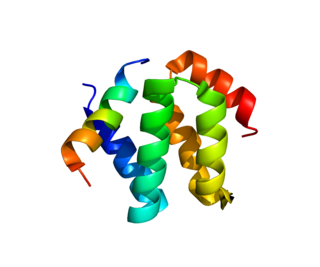Protocadherin-15 is a protein that in humans is encoded by the PCDH15 gene. [5] [6] [7]
Protocadherin-15 is a protein that in humans is encoded by the PCDH15 gene. [5] [6] [7]
This gene is a member of the cadherin superfamily. Family members encode integral membrane proteins that mediate calcium-dependent cell-cell adhesion. The protein product of this gene consists of a signal peptide, 11 extracellular calcium-binding domains, a transmembrane domain and a unique cytoplasmic domain. It plays an essential role in maintenance of normal retinal and cochlear function. [7] It is thought to interact with CDH23 to form tip-link filaments. [8]
Mutations in this gene have been associated with hearing loss, which is consistent with its location at the Usher syndrome type 1F (USH1F) critical region on chromosome 10. [7] Variation within it has also been found to be associated with normal differences in human facial appearance. [9]

Usher syndrome, also known as Hallgren syndrome, Usher–Hallgren syndrome, retinitis pigmentosa–dysacusis syndrome or dystrophia retinae dysacusis syndrome, is a rare genetic disorder caused by a mutation in any one of at least 11 genes resulting in a combination of hearing loss and visual impairment. It is a major cause of deafblindness and is at present incurable.

Usherin is a protein that in humans is encoded by the USH2A gene.

Clarin-1 is a protein that in humans is encoded by the CLRN1 gene.

Harmonin is a protein that in humans is encoded by the USH1C gene. It is expressed in sensory cells of the inner ear and retina, where it plays a role in hearing, balance, and vision. Mutations at the USH1C locus cause Usher syndrome type 1c and nonsyndromic sensorineural deafness.

Cadherin-23 is a protein that in humans is encoded by the CDH23 gene.

Usher syndrome type-1G protein is a protein that in humans is encoded by the USH1G gene.

Protocadherin 11 X-linked, also known as PCDH11X, is a protein which in humans is encoded by the PCDH11X gene.

Protocadherin-1 is a protein that in humans is encoded by the PCDH1 gene.

Protocadherin gamma-C3 is a protein that in humans is encoded by the PCDHGC3 gene.

Protocadherin-8 is a protein that in humans is encoded by the PCDH8 gene.

Protocadherin-17 is a protein that in humans is encoded by the PCDH17 gene.

Protocadherin-10 is a protein that in humans is encoded by the PCDH10 gene.

Protocadherin-7 is a protein that in humans is encoded by the PCDH7 gene.

Protocadherin-12 is a protein that in humans is encoded by the PCDH12 gene.

Transmembrane channel-like protein 1 is a protein that in humans is encoded by the TMC1 gene. TMC1 contains six transmembrane domains with both the C and N termini on the endoplasmic side of the membrane, as well as a large loop between domains 4 and 5. This topology is similar to that of transient receptor potential channels (TRPs), a family of proteins involved in the perception of senses such as temperature, taste, pressure, and vision. TMC1 has been located in the post-natal mouse cochlea, and knockouts for TMC1 and TMC2 result in both auditory and vestibular deficits indicating TMC1 is a molecular part of auditory transduction.

Myosin-XV is a protein that in humans is encoded by the MYO15A gene.

Protocadherin-18 is a protein that in humans is encoded by the PCDH18 gene.

Protocadherin-20 is a protein that in humans is encoded by the PCDH20 gene.

Protocadherin Fat 4, also known as cadherin family member 14 (CDHF14) or FAT tumor suppressor homolog 4 (FAT4), is a protein that in humans is encoded by the FAT4 gene.
Protocadherin 19 is a protein belonging to the protocadherin family, which is part of the large cadherin superfamily of cell-adhesion proteins. The PCDH19 gene encoding the protein is located on the long arm of the X chromosome.